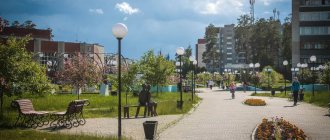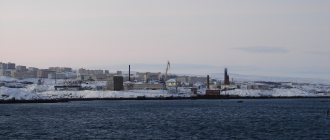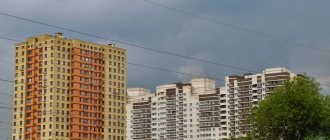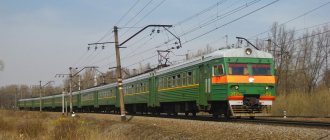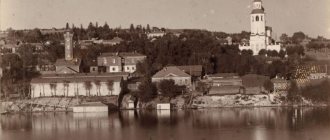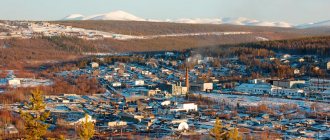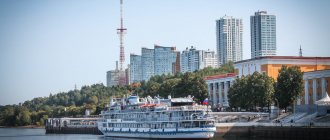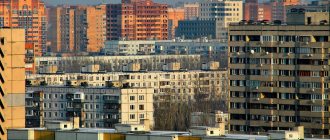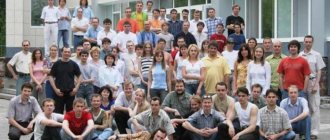75 years ago, in 1945, work began on the creation of nuclear weapons in the USSR.
In 1950, the Soviet Union was declared to have an atomic bomb. In 1965, the creation of the Strategic Missile Forces was completed. The leading role in this was played by the closed city of Zarechny (formerly Penza-19), where the serial assembly of strategic missiles was established for the first time in the world.
Today in Russia there are 38 ZATOs (closed administrative-territorial entities). 10 of them, including Zarechny, are the territory of Rosatom, the rest belong to the Ministry of Defense and Roscosmos. 1.5 million people live in these single-industry towns. Zarechny is the most compact: 22 square meters. 65 thousand people live in km. For comparison: the ZATO Sarov has a population of 95 thousand, and the territory is 8 times larger. The city of Zarechny can be walked from end to end in half an hour.
They say that it began to be built in the peat bogs of the Penza region according to the “atomic” project of Beria . According to legend, in the 1960s they intended to assemble the world's largest atomic bomb here. But they didn’t, because they couldn’t find a suitable crane.
A bomb without illusions and speculation. Fragments of the history of the USSR Atomic Project Read more
Unknown Russia
THEN is surrounded by a state-type border - with the difference that here they say not “border”, but “perimeter”. The perimeter is a barrier that allows you to ensure the protection of state secrets and protected objects. Plus the safety of people is the cutoff that does not allow just anyone to come here. The perimeter of Zarechny borders on the outskirts of Penza on three sides, and on the fourth - with the Penza district. From here to the center of Penza, if there are no traffic jams, is a 15-20 minute drive across the bridge. Locals joke: “There is Moscow and Zamkadye. There are Zarechny and Zakolyuchye..."
In “Zakoluchye” life is different - in some ways better, in some ways worse. But 80% of Zarechensk residents do not want to part with the “perimeter” - they, of course, do not pray for it, but they also do not want to open the city to all winds. And moreover, even 10 years ago they were ready to pay the tax themselves for the maintenance of the local military unit and the cordon around the city, if suddenly the state did not have the money for it. Now, due to the improvement of the situation in the country, the attitude towards “Zakoliuchaya” is changing - its realities are no longer so feared.
The moose in the sandbox does not surprise local residents. The usual picture. Photo from the newspaper “Zarechye Segodnya”
This can be called a kind of social reserve. “In the 90s, the waves of devastation that swept across the country crashed against the walls of Zarechny,” explains the head of the city Oleg Klimanov . — There was no shock therapy or protests regarding the monetization of benefits. Behind the regime “thorns” an oasis of a better life has survived.” Since the 1990s, the question of “will they open or not” has been acute. In 2015, the last attempt was made to abolish the perimeter: on the initiative of the Ministry of Economic Development, a draft decree of the President of the Russian Federation appeared, which liquidated the Zarechny ZATO as a city. This initiative received strong resistance from Rosatom and law enforcement agencies. The issue was closed, and now few people remember about it.
Residents of Zarechny perceive the “state border” and the regime as something inevitable and ordinary, like traffic police posts on the road. People refer to the city as “thorn” or “zone”. "Where do you live?" - “In the zone.” Without any shade of thieves’ romance: “zone” simply means a special place. They don’t say “checkpoint”, but “checkpoint”, like in a factory. In the vacant lots along the perimeter there are fences of garage cooperatives - a “Chinese wall”. If someone violates the border, the incident is reported on local radio-TV. Residents call the outposts - the whole city is “catching a spy.” One day an elderly woman called: “A non-local man has settled here.” It turned out that the stray guy came to visit his relatives for a funeral and ended up staying with a friend.
Zarechny. Penza is on the horizon. Photo: www.zarechny.zato.ru
The atmosphere of the sanatorium
I pass the checkpoint along with everyone else. There is no queue at the checkpoint: it only happens when a special regime is introduced. A Russian Guard sentry takes away and then returns my passport. I walk into the streets and look around inside the “zone”: here is the same Russia and at the same time not quite the same.
In appearance, it is an ordinary city, but with its own special character, it gives residents a feeling of security: there is crime here, but its level is lower - Zarechny occupies one of the last places in the region in terms of this indicator. There are no bars on the windows of the first floors, and garages are built without the expectation of breaking in: the walls are half brick and boards. Any crime here is an emergency on an urban scale. In Zarechny there are no contract killings, organized crime, corruption, raider takeovers or black redistribution of property. There are no brothers, homeless people, stoned drug addicts and degenerate drunks. One theft a year, and then “ride and quit.” Not so long ago, children and parents traditionally left apartment keys under mats at the entrance doors. In the evening the streets are quiet, like in a sanatorium. The city is sometimes informally called a sanatorium. People emphasize: “It is important for me that I can let my child go out until late and I will be sure that no one will touch him...” The retail outlets are not occupied by visitors, and there are no migrants from the southern republics in unskilled jobs. There are no migrants at all - none. Only yours.
Article on the topic
Uranus, comrades! How is life in the once most closed city of the nuclear industry?
Another sign is that the city does not have a developed entertainment infrastructure. Only the year before last a multiplex cinema of a modern format appeared, and it is not in great demand. There are no restaurants or large shopping centers, only small cafes, and those are rare. “It’s easier for people to go to Penza, have fun there from the heart, return home and live here in a calm environment, surrounded by centuries-old pine trees, without noise and commotion,” explains Klimanov. “But the residents of Zarechensk themselves are engaged in landscaping their yards - the city authorities give them land, seedlings, and flowers.”
Another custom is a demonstration on City Day. Half of the residents with banners, children and balloons walk across the square - the other half watches. They hold graduation ceremonies together: parents and their children-students, holding hands, take turns crossing the square, and the mayor calls them by name into a microphone and thanks them: “Thank you for your son” (or for your daughter). The whole city is seeing off conscripts into the army. They carry out cleanup days: families go to parks and squares, bring out cauldrons of pilaf, barbecue, and clean up the alleys while listening to music.
Demonstration on City Day. Photo: www.zarechny.zato.ru
And residents can easily call the head of the city. Once, a grandmother was soaked for a long time in the rain at a bus stop, could not stand it and took out a mobile phone from her bag, which her grandson had given her: “It’s a disgrace! I’ve been waiting for the bus for half an hour!” “I am present on all social networks, so many people contact me directly with their problems,” says the mayor. — Almost all residents know my cell phone number. Here, look (shows messages on his phone): the child’s mother asks to install a fence near the school, residents write about paving the sidewalk and turning off the water. And I react - although, to be honest, I’m not a supporter of manual control.”
Residents of Zarechensk say: “In the wild we have coarsened morals, but our skin is too soft,” “If the ‘thorn’ is removed, we will find ourselves like a high school student in a company of punks.” The punks in this metaphor are not Russia, but the foam of the era, which has always remained outside the perimeter... Therefore, one inevitably thinks: should the ZATO be lowered to the level of the entire country, or, conversely, should the entire country be brought up to the standard of living of the “trans-residents”? You can’t surround half of Russia with thorns.
LiveInternetLiveInternet
Wednesday, July 01, 2015 22:28 + to quote book
Zarechny is a city of regional significance in the Penza region of Russia. It belongs to closed administrative-territorial formations (ZATO), on its territory a special regime of life has been established, including special living conditions for citizens. The city is located 12 km east of Penza, borders the Selixa railway station on the Penza-Syzran line.
Coat of arms
“In a field dissected by azure (blue, light blue) and greenery, there is a narrowed pillar burdened with a lowered beam at the waist and surrounded by two elongated cyclamors in the left and right belts with bezants on top of the right on the left and on top of the left on the right; all the figures are golden.”
The content of the coat of arms is uniform and harmonious: the figures symbolize the city of Zarechny and its inhabitants as workers who make a huge intellectual, scientific, theoretical and practical contribution to the development of the city.
The history of the emergence and development of the city of Zarechny is inextricably linked with the development of the nuclear industry in our country. The main figure of the coat of arms - two elongated cyclamoras crosswise symbolize atomic orbits, indicating the city-forming enterprise, the largest industrial enterprise of the Ministry of Atomic Industry of Russia - FSUE PA "Start".
The narrowed pillar, encumbered with a lowered beam at the waist, contours the silhouette of the city's Victory Obelisk, which was used in the old emblem. This preserves the continuity of symbolism.
The narrowed pillar, encumbered with a lowered bar at the waist, simultaneously resembles a sword - a handle, a hilt and a blade going up.
The sword is a symbol of protection and justice, embodies courage, fortitude, heroism, courage and valor of the townspeople, and also allegorically speaks of the role of the enterprise and the city itself in the defense of the country.
Gold is a symbol of strength, wealth, intelligence, justice, respect.
The dissection of the field into azure and green allegorically shows the convenient geographical location of the city near the regional center - the city of Penza, on the East European (Russian) Plain, a favorable combination of natural conditions for human health - flat terrain, moderately hot summers, moderately cold winters, low swampiness , relatively high forest cover.
Azure is a symbol of fidelity, impeccability, honor, virtue.
Green color is a symbol of freedom, abundance, joy, life.
Zarechny is a city of comfortable living conditions. About a third of it is built up, and the rest is preserved natural forests. Everyone who comes to Zarechny calls it a resort city for its green streets, squares and city parks, for its comfortable urban development and the hospitality of its residents.
The oldest historical monuments found on the territory of Zarechny include a settlement and three villages. Hundreds and thousands of years ago they represented a whole complex of settlements, which included a fortified fortress (fortified settlement) and several unfortified residential settlements.
Zarechenskoe village. Discovered in 1999, the dating of the settlement is determined to be between the 4th and 11th centuries. It is a major monument of ancient Mordovian culture. It ceased to exist due to colonization at the beginning of the 11th century. Volga Bulgaria of the Upper Sur lands.
Akhun settlement. Dates from the end of the 1st millennium BC. e. - mid-1st millennium AD e., is included in the list of objects of historical and cultural heritage of federal significance. Located within the city, on a steep cape near the ravine in the forest, on the southern edge of the Suitcase ravine; occupies an area of up to 350 sq. m.
The settlement was discovered in 1956 and surveyed in 1963, 1964, 1974. local historian M.R. Polesskikh.
From the 11th to the 17th centuries. The territory of the city and its surroundings were not inhabited. Only at the beginning of the 17th century. Mordovian hunters, fishermen and beekeepers appeared here, attracted by the richness of forest lands and the abundance of local fauna. The forest plots adjacent to Zarechny were assigned by them as hereditary possessions, for which grain and monetary dues were paid to the treasury.
At the same time, Russian colonization of the Sur lands began, primarily by representatives of the “service class”, who carried out security service within the borders of the abatis and were given land ownership for this. In this way, the nobleman Fyodor Ivanovich Chemodanov, the future Penza governor, who gave the name to the village neighboring our city, received his vast land holdings from the tsar. His estate included most of the Zarechensk territory.
In the 2nd half of the 17th century. In the forest, on the site of the modern village of Akhuny, the Forerunner of the Mother of God-Odigitriev Monastery arose. According to Penza local historian V.Yu. Samsonov, the monastery was connected with Penza by a long underground passage that reached its fortifications. For a long time, schismatics and representatives of tax-paying classes who fled from conscription and taxes found shelter in the monastery and the nearby Zarechensky forests. At the end of the reign of Peter I, the monastery was destroyed, which was associated with the activities of one of its descendants - the monk Varlaam, who publicly anathematized the first Russian emperor.
There was also a leader of the peasant war of 1773-75 in our area. Emelyan Pugachev, who was massively supported by the “ignoble” population of the Penza region. It is known that at the end of July 1774, on the eve of entering Penza, his troops visited the Zarechny region.
In the 18th century The northeastern part of Zarechny was occupied by the forest estates of the nobles Ermolaevs, Dubenskys, Morozovs and Pechorins.
The proximity of the Simbirsk Highway contributed to frequent visits by officials. Emperor Alexander I, who visited the estate of the Mikhailovsky-Danilevsky landowners in Chemodanovka in 1824, did not reach the future ZATO. The southwestern (forest) part of this estate was also located on the territory of our city. Transport links were intensified by the construction of the Mokshano-Syzran railway in the 70s. XIX century It was then that the Selix railway station was built.
After the revolution, on the site of Zarechny there were two forest cordons. One was located in 131, the other in 132 quarters of the Zasursky forestry. The cordon of the 131st quarter was a single-apartment house, built in 1937, with outbuildings located next to it: a stable, a carriage house, a barn with a cellar. On block 132 there was a two-flat house, a stable, a carriage house, a barn, a chicken coop, a cellar and a bathhouse.
The forestry cordons bordered the village at Seliksa station, which during the Great Patriotic War became the base for the formation of the largest military formations in the Penza region.
It is known that even before the revolution, a training ground and training camps for the tsarist army were located in the forests near Seliksa. Subsequently, they came under the jurisdiction of the Red Army. From 1939 to June 1941, the 107th separate communications battalion of the 61st Infantry Division was stationed at the station. Immediately after the start of the war, the division was supplemented with recruits from the Penza region and sent to the Western Front. While fighting heavy battles, the division was surrounded in August 1941, from which only a few Red Army soldiers managed to escape.
The front-line soldiers said: “Whoever visited Selix is not afraid of death.” In the memory of many veterans, training camps were preserved as places where recruits died from hunger, cold and disease. The reason for this was the poor supply of rear training units during the war, as well as direct theft on the part of the command staff. In January 1942, the Seliksen brigade was even visited by People’s Commissar K.E. with an inspection. Voroshilov, who harshly punished all those guilty of negligence and waste.
It is unknown what would have happened to the territory of the future city of Zarechny if not for the Soviet nuclear project. Back in 1954, the Penza City Council planned to build a dacha-type village next to the Selixa station: with residential areas, streets and squares, squares and parks. However, it was not possible to realize the plan: soon the construction of a secret plant and a city near it began in the same place.
Construction work on the territory of Zarechny began in March 1955. However, back in 1953, geologists came here, and a little later - surveyors and topographers. Their first conclusions were very disappointing: the explored area was very swampy and overgrown with dense forest, with numerous lakes on the site of the construction of future industrial facilities.
However, from the point of view of the country's leadership, this place was ideal for solving state defense problems in terms of camouflage and logistics. Therefore, already on New Year’s Eve 1955, the first train with Siberian larch arrived at the Selixa station, and by 1956, on the site of the modern 132 sq. An entire workers' settlement was erected with dormitories in the form of one-story barracks. In the same year, the foundation of the first stone houses on the street was laid. Sports etc. World. The construction of factory buildings proceeded at a rapid pace, and social facilities were also built: a hospital campus, kindergartens and schools, a cultural center.
By 1961, construction of the plant within the scope of the project was completed. A modern instrument-making plant was created, employing more than 4,000 people. The enterprise has mastered the production of 31 types of electromechanical devices, pressure instruments, automation units and other products. Radio engineering production arose, a wide range of on-board and ground-based equipment for radio telemetry systems, dozens of types of products developed by VNIIEF and VNIIA were mastered.
In the early 1960s. The implementation of the second stage of construction of the enterprise began, providing for the organization of a new production - the assembly of nuclear weapons. The first product independently assembled at the enterprise was a nuclear warhead developed by VNIITF (Snezhinsk) for the first underwater-launched ballistic missile. In subsequent years, the production of a wide variety of nuclear weapons of various types and purposes was mastered.
On March 3, 1962, the city of Zarechny changed its official name to Penza-19 and finally turned into a territory closed from the outside world, surrounded along the perimeter by barbed wire and checkpoints.
In January 1992, the historical name Zarechny was returned to the city. Until 1994, the city was absent from all maps; to this day, a special access regime is observed, provided for by the status of a ZATO.
Today the city is rightfully considered one of the leaders in the field of socio-economic development. The management of Zarechny rightfully considers the preservation of traditions laid down by previous generations of citizens to be the most important factor for success. Multiplying what has been achieved, the city does not slow down, time after time becoming the winner of various competitions of federal, regional and industry significance.
| Categories: | Cities of Russia/Starting with the letter *Z* |
Cited 1 time Liked by: 3 people
Like share
0
Like
- 3
I liked the post - Quoted
- 0
Saved
- Add to quote book
- 0
Save to links
Liked3
0
"Pleasures" of the mode
Another local concept is “regime” with its own specifics. Here it is as constant and influences life as the rising and setting of the sun: for example, passing by a children's playground, you can hear first-graders exchanging horror jokes about “violations of the regime.” And this is not about the daily routine.
The essence of the ZATO regime is that people who do not have a direct connection to the city cannot cross its borders. To get into or out of the territory, residents must present a pass, and “strangers” who arrived with a temporary pass are always visible here. Friends and relatives living “on the other side” cannot come to Zarechensk residents just like that: it takes a month, or even more, to prepare documents for passage beyond the perimeter. For example, they gave me a temporary pass for two months. Previously, only close relatives could come here to visit—and then only once every 5 years. Then the quota for “times” was cancelled. There was a case when a woman decided to get married on the side and asked the local authorities: “Allow my husband to live in Zarechny.” The competent authorities checked him and said: “He is being judged under specific articles. It is forbidden".
Monument to the Pass. Opened in 2013. Photo: www.zarechny.zato.ru
There are other delights of life in lockdown. For example, there is a restriction on travel, which, however, is only relevant for those who have security clearance. Until the early 90s, strict rules of non-disclosure of state secrets were in force for residents of Zarechensk: in the wild you could not say where you were from, even if the police stopped you on vacation without a passport. “Answer that you are from Penza itself,” they were instructed to depart. And often peaceful people found themselves in the most absurd situations, finding themselves in the role of spies... The reasons for vigilance are serious. One intelligence officer defined it this way: “If five secret carriers left here and got together, they could build a homemade nuclear warhead in the garage. And if the protection that many here are accustomed to from birth falls, the brains of the creators of the nuclear shield will flow to Los Alamos” (a giant closed city in the USA).
Article on the topic
Life in a mailbox. History of closed cities in Russia and the USSR
“ZATO status is not so simple,” says Klimanov. — By law, we are limited in our rights: regime, the ability to conduct full-fledged business activities, travel abroad, etc. The state compensates us financially for these prohibitions. 40% of the city budget comes from federal subsidies, which go to support social and engineering infrastructure. Therefore, compared to what surrounds us, the social life and living conditions here are often much better.” By the way, Zarechny is the only ZATO where the population is growing (in others it is decreasing). Although, this is not due to natural profit, but due to migration - someone gets a job, someone transports relatives.
Through another checkpoint I pass into the territory of the city-forming enterprise “Start” - the core on which Zarechny’s life rests. Now it is a federal research and production center, which is part of the Rosatom nuclear weapons complex. “Here they produce high-tech products that are used to ensure the national security of the country, for the needs of nuclear energy, fuel and energy enterprises and other industrial facilities,” explains the general director of the enterprise, Sergei Baidarov . — The association includes NIKIRET, one of the leading enterprises in Russia, specializing in the development and manufacture of technical security equipment. With the help of the TSO of his production, the Sochi Olympics were protected: the admission system through which 20 million people passed there was made in Zarechny. The facilities of the 2018 FIFA World Cup and other major sporting events were also equipped with access control and management systems, which were developed, manufactured, installed and maintained by the plant’s employees.” In addition, Start produces copying manipulators and much other equipment for the benefit of the nuclear industry.
Start Software Museum. Housing of a special combat charging compartment of a torpedo. Photo from the fund of the Zarechny Museum and Exhibition Center
Today, the plant employs 6 thousand people—a third of the city’s population employed in the manufacturing sector. The average salary is 41 thousand rubles - higher than the industry average in Penza. There is almost no turnover: there are enough candidates for employment, but only highly qualified specialists are hired. Several hundred employees are residents of Penza. “The conditions in Zarechny are attractive,” comments Baidarov, “many would like to stay here.”
However, the city cannot provide work not only to everyone who wants it because of the perimeter, but also often to its own residents. The proximity of Penza helps: many people from Zarechnyi work there. This causes pendulum migration in the morning and evening: when local residents go to work in Penza and, conversely, Penza residents go to the closed city. Every day 6–8 thousand people move back and forth.
But the situation may soon change: in 2022, a number of districts of Zarechny were given the status of territories of advanced socio-economic development (today there are already three residents in the city’s TASED). The goal is to attract investors who would create civilian high-tech industries with high-paying jobs there. This will contribute to the influx of qualified specialists, the emergence of new businesses and the fact that Zarechny will cease to be a single-industry town. If, of course, the international situation in Zakoluchye allows it.
Are Zarechny being prepared for opening? How the property of a closed city goes into private hands
The next wave of rumors about the opening of the closed city of Zarechny has a specific basis.
Once state-owned enterprises began to sell into private hands. This is a common occurrence for Penza. And for a closed city with military production, this is already a reason to think about the future. In Zarechny, rumors that frighten the townspeople are once again spreading about the imminent removal of the special status of a closed city from the city. Let us recall that in 2015, the Ministry of Economic Development of the Russian Federation prepared a document on the opening of 6 Rosatom cities from January 1, 2016.
However, the order was quickly canceled, since the mayors of the closed administrative unit managed to prove that this measure was premature.
However, a new reason appeared that gave rise to talk about the opening of Zarechny. The largest strategic enterprise of the Closed Administrative Unit, MUP "Gorelektroset" of the city of Zarechny, was allegedly bought out by private owners. According to the Unified State Register of Legal Entities, currently a municipal enterprise with an authorized capital of more than 61 million rubles is in the process of liquidation. The company received this alarming status in June 2020.
And now there is talk in the city that Zarechny may lose its ZATO status from January 1, 2022. There are no links to any official document, as was the case in 2015.
Meanwhile, the infrastructure of Zarechny has been prepared for opening for a long time - an Ice Palace and a swimming pool have been built in the city, which clearly exceeds the needs of a city with a small population in terms of the number of seats. A modern perinatal center has also been built, which before the coronavirus received patients from all over the region and neighboring regions.
In addition, the city's heating networks have been commercialized. And at the moment they are planning to transfer the municipal unitary enterprise “Gorelektroset” into private hands. The municipality is getting rid of property, the maintenance of which requires quite a lot of budgetary funds.
A note should be made here. In Penza, the process of squandering municipal unitary enterprises is a common and irreversible phenomenon. We have been seeing this for more than ten, or even fifteen years. But while Penza was destroying its municipal unitary enterprise PPP, Zarechny retained the municipal transport enterprise and kept fares within reasonable limits for a long time.
Therefore, even rumors about the sale of the municipal unitary enterprise “Gorelektroset” frighten the townspeople. The company was founded in 1992. According to data from open sources, since 2011, the MUP has been consistently making a profit.
The authorized capital of the enterprise is more than 61 million rubles, and the only founder is the city of Zarechny. The affairs of the Municipal Unitary Enterprise are managed by the Municipal Property Management Committee.
Gorelektroset is still headed by Viktor Shoshkin. In 2017, he was elected to the Legislative Assembly, but his luck failed him. In the same year, it became known that the MUP had problems with the only regional bank.
If the municipal enterprises of Zarechny are really planning to be handed over to private hands, then this eloquently indicates that the issue of opening Zarechny has not been removed from the agenda of the Government of the Russian Federation, but has only been postponed for some time.
And yet, the mayor of the ZATO, Oleg Klimanov, officially stated through local media that there are no plans to open Zarechny in the near future.
Plans to remove Zarechny’s special status frighten townspeople primarily by the possible loss of their usual comfort zone. They say that the well-groomed parks and squares of the city can be chosen by marginalized individuals from all over the area - then goodbye to the improvement of the streets, which they are so proud of in Zarechny.
And another concern of Zarechny residents is related to the fact that if the city is opened, Zarechny could become one of the microdistricts of Penza. And this, in their opinion, is again fraught with the loss of the usual improvement of urban areas. So, even groundless rumors about the possible opening of the city are perceived very painfully by residents of Zarechensk.
